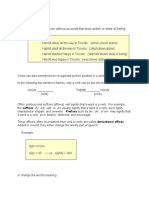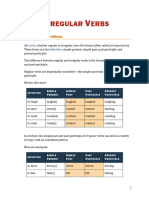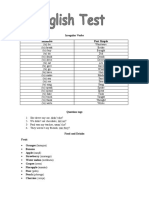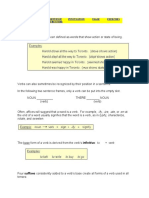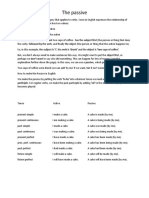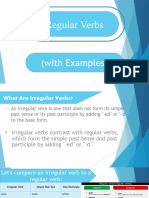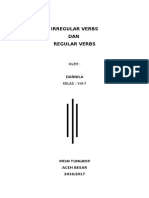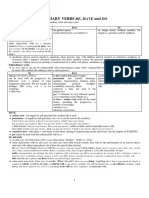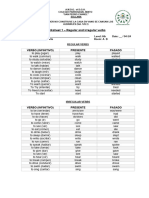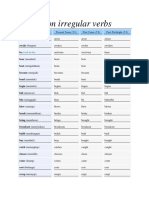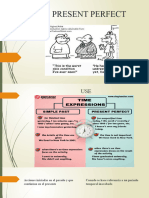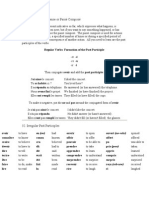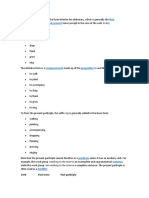Verb Use Practice
Verb Use Practice
Uploaded by
David CrouchCopyright:
Available Formats
Verb Use Practice
Verb Use Practice
Uploaded by
David CrouchCopyright
Available Formats
Share this document
Did you find this document useful?
Is this content inappropriate?
Copyright:
Available Formats
Verb Use Practice
Verb Use Practice
Uploaded by
David CrouchCopyright:
Available Formats
MODULE 6: USING VERBS CORRECTLY
REGULAR VERBS
6a The four principal parts of a verb are the present, the present participle, the
past, and the past participle.
EXAMPLES We walk to school. [present of walk]
We are walking home. [present participle of walk]
We walked to the store. [past of walk]
We have walked for hours. [past participle of walk]
Notice that the tenses made from the present participle and past participle use helping
verbs, such as am, is, are, has, and have.
6b A regular verb is a verb that forms its past and past participle by adding -d
or -ed to the present.
Present Present Participle Past Past Participle
happen (is) happening happened (have) happened
create (is) creating created (have) created
carry (is) carrying carried (have) carried
The present participle of most regular verbs ending in -e drops the -e before adding -ing.
NOTE A few regular verbs have an alternate past form ending in -t. For example, the
past form of burn is burned or burnt.
EXERCISE 1 Writing the Correct Forms of Regular Verbs
For each of the following sentences, decide what the correct form of the italicized verb
should be. Write the correct verb form on the line in the sentence.
EX. Last night’s train (arrive) arrived on time.
1. Ashur has (admit) ___________________ that he forgot the flowers.
2. Before she left, Lien (pledge) ___________________ to return.
3. Yes, we have (create) ___________________ a new gumbo.
4. My sister, who loves gardening, is (plant) ___________________ both fruits and
vegetables.
5. Although we (hurry) ___________________, we missed the bus.
© Houghton Mifflin Harcourt Publishing Company Module 6 1
6. During World War II, hundreds of Navajos in the U.S. Marines (work)
___________________ as Code Talkers.
7. The club members are (urge) ___________________ us to join.
8. What has (happen) ___________________ to that building?
9. The method that Thelma is (use) ___________________ was developed in India.
10. Yesterday morning the class (watch) ___________________ a documentary about
pollution.
11. The rest of the workers have (decide) ___________________ to follow my
suggestion.
12. Every morning last month we (listen) ___________________ to a weather report.
13. Ms. Perkins has (correct) ___________________ the errors.
14. I think that dog is (follow) ___________________ us!
15. The online radio station (play) ___________________ my two favorite songs last
night.
16. Our neighbor down the street is (move) ___________________ to another town.
17. I (promise) ___________________ that I would feed the cat every morning.
18. Sheila (search) ___________________ for hours, but she could not find her keys.
19. Our art class is (visit) ___________________ the museum today.
20. Because the fans have (wait) ___________________ for a long time, they are
getting restless.
© Houghton Mifflin Harcourt Publishing Company Module 6 2
MODULE 6: USING VERBS CORRECTLY
IRREGULAR VERBS
6c An irregular verb is a verb that forms its past and past participle in some
other way than by adding -d or -ed to the present.
Irregular verbs form their past and past participle by changing vowels, changing
consonants, adding -en, or making no change at all.
Present Past Past Participle
begin began (have) begun
go went (have) gone
take took (have) taken
set set (have) set
Since most verbs are regular, people sometimes try to make irregular verbs follow the
same pattern. However, words such as knowed and thinked are nonstandard. If you are
not sure about the parts of a verb, look in a dictionary that lists the principal parts of
irregular verbs.
When the present participle and past participle forms are used as main verbs (simple
predicates) in sentences, they always require helping verbs.
Present Participle + Helping Verb = Verb Phrase
running forms am running
driving + of = was driving
seeing be were seeing
Past Participle + Helping Verb = Verb Phrase
run forms have run
driven + of = has driven
seen have had seen
© Houghton Mifflin Harcourt Publishing Company Module 6 3
IRREGULAR VERBS FREQUENTLY MISUSED
Present Present Participle Past Past Participle
begin (is) beginning began (have) begun
blow (is) blowing blew (have) blown
break (is) breaking broke (have) broken
bring (is) bringing brought (have) brought
burst (is) bursting burst (have) burst
choose (is) choosing chose (have) chosen
come (is) coming came (have) come
dive (is) diving dove (or dived) (have) dived
do (is) doing did (have) done
drink (is) drinking drank (have) drunk
drive (is) driving drove (have) driven
eat (is) eating ate (have) eaten
fall (is) falling fell (have) fallen
freeze (is) freezing froze (have) frozen
give (is) giving gave (have) given
go (is) going went (have) gone
grow (is) growing grew (have) grown
know (is) knowing knew (have) known
make (is) making made (have) made
put (is) putting put (have) put
ride (is) riding rode (have) ridden
ring (is) ringing rang (have) rung
run (is) running ran (have) run
see (is) seeing saw (have) seen
shake (is) shaking shook (have) shaken
shrink (is) shrinking shrank or shrunk (have) shrunk or shrunken
sink (is) sinking sank or sunk (have) sunk or sunken
speak (is) speaking spoke (have) spoken
steal (is) stealing stole (have) stolen
sting (is) stinging stung (have) stung
strike (is) striking struck (have) struck
swear (is) swearing swore (have) sworn
© Houghton Mifflin Harcourt Publishing Company Module 6 4
IRREGULAR VERBS FREQUENTLY MISUSED
Present Present Participle Past Past Participle
swim (is) swimming swam (have) swum
take (is) taking took (have) taken
tear (is) tearing tore (have) torn
throw (is) throwing threw (have) thrown
wear (is) wearing wore (have) worn
write (is) writing wrote (have) written
EXERCISE 2 Choosing Correct Irregular Verbs
Change each of the verb forms below. If the present is given, change it to the present
participle. If the present participle is given, change it to the past form. If the past form is
given, change it to the past participle. Use have before the past participle form and is
before the present participle form.
EX. ran have run is diving dove
1. see _________________ 11. speak _________________
2. spoke _________________ 12. is choosing _________________
3. is freezing _________________ 13. wear _________________
4. threw _________________ 14. knew _________________
5. is breaking _________________ 15. ride _________________
6. brought _________________ 16. shook _________________
7. grow _________________ 17. is eating _________________
8. drove _________________ 18. went _________________
9. is swimming _________________ 19. take _________________
10. began _________________ 20. drank _________________
EXERCISE 3 Identifying Correct Forms of Irregular Verbs
For each of the following sentences, underline the correct form of the verb in parentheses.
EX. Those plants have (grew, grown) taller.
1. The class (chose, chosen) new officers last week.
2. Did you know your rear axle has (broke, broken)?
3. An earthquake (struck, strike) the Phillipines earlier today.
© Houghton Mifflin Harcourt Publishing Company Module 6 5
4. I’m afraid your sweater (shrank, shrunk) in the wash.
5. About four inches of rain has (fell, fallen) since yesterday.
6. Anika angrily (tore, torn) the letter into bits.
7. My grandfather has (wrote, written) several articles for National Geographic.
8. You can try after Rudy has (dove, dived) off the board.
9. The concert has (began, begun), but you have not missed much.
10. Mr. Katz (shaken, shook) his head in reply.
EXERCISE 4 Using Irregular Verbs
In the space provided, write 10 sentences using verbs from the charts in module section 6c.
Use the participle forms of the verbs in five of your sentences. Underline the verbs you use.
EX. Frederick has brought us a bushel of apples.
© Houghton Mifflin Harcourt Publishing Company Module 6 6
MODULE 6: USING VERBS CORRECTLY
VERB TENSE
6d The tense of a verb indicates the time of the action or of the state of being
expressed by the verb.
Every verb has six tenses.
Tense Examples
Present I throw, you throw, he throws, we throw
Past I threw, you threw, she threw, they threw
Future I will (shall) throw, you will throw, they will throw
Present Perfect I have thrown, you have thrown, he has thrown
Past Perfect I had thrown, you had thrown, she had thrown
Future Perfect I will (shall) have thrown, you will have thrown, we will
have thrown
Each of the six tenses has an additional form, called the progressive form, expresses a
continuing action. It consists of a form of the verb be plus the present participle of a verb.
The progressive is not a separate tense but an additional form of each of the six tenses.
Form Examples
Present Progressive am/are/is throwing
Past Progressive was/were throwing
Future Progressive will (shall) be throwing
Present Perfect Progressive has/have been throwing
Past Perfect Progressive had been throwing
Future Perfect Progressive will (shall) have been throwing
6e Do not change needlessly from one tense to another.
INCONSISTENT Elia drove to the store and buys lunch. [Drove is past tense; buys is
present tense.]
CONSISTENT Elia drove to the store and bought lunch. [Drove and bought are
both past tense.]
© Houghton Mifflin Harcourt Publishing Company Module 6 7
EXERCISE 5 Identifying Verb Tenses
For each sentence below, identify the tense of the verb.
EX. past perfect Kam had seen the movie.
1. ___________________________ The team traveled by bus.
2. ___________________________ Leila has taken her medicine.
3. ___________________________ The conference will begin on Monday.
4. ___________________________ We swim on Friday evenings.
5. ___________________________ Phillip had already seen the movie.
EXERCISE 6 Proofreading a Paragraph for Consistent Verb
Tenses
Decide whether the paragraph below should be written in the present or past tense. Then
draw a line through each incorrect verb form, and write the correct form above it.
ate
EX. I eat too quickly, so I got these hiccups.
[1] Yesterday, my hiccups continue for a while, so my friends gave me advice.
[2] Maripat tells me to hold my breath and count to 10. [3] Shing says that I should
quickly drink a tall glass of water. [4] Finally, my sister went into the kitchen and jumps
back in the room yelling, “Boo!” [5] She scares me so much that my hiccups vanished.
EXERCISE 7 Using Verb Tenses and Forms Correctly
Write five sentences showing the correct use of the verb bring. Use as many different
verb tenses and forms as you can. Underline each verb, and label its tense or form.
EX. Dad is bringing my sister Leta to watch my game. (present progressive)
1. ___________________________________________________________________
2. ___________________________________________________________________
3. ___________________________________________________________________
4. ___________________________________________________________________
5. ___________________________________________________________________
© Houghton Mifflin Harcourt Publishing Company Module 6 8
MODULE 6: USING VERBS CORRECTLY
ACTIVE AND PASSIVE VOICE
6f A verb in the active voice expresses an action done by its subject. A verb in
the passive voice expresses an action done to its subject.
ACTIVE VOICE Mr. Noor helped Sarah. [The subject, Mr. Noor, performed the action.]
PASSIVE VOICE Sarah was helped by Mr. Noor. [The subject, Sarah, received the
action.]
NOTE In a passive sentence, the verb phrase always includes a form of be and the past
participle of the main verb. Other helping verbs may also be included.
The passive voice emphasizes the person or thing receiving the action. It may be used
when the speaker does not know or does not wish to say who performed the action.
SUBJECT
PASSIVE VOICE A window was broken by someone last night.
SUBJECT OBJECT
ACTIVE VOICE Someone broke a window last night.
In general, you should avoid using the passive voice because it makes your writing sound
weak and awkward. Using the active voice helps make your writing direct and forceful.
EXERCISE 8 Classifying Sentences by Voice
Identify each of the following sentences as active or passive. On the line before each
sentence, write A for active or P for passive.
EX. A Pat Cummings illustrates books.
___________ 1. She has been advised by Tom Feelings.
___________ 2. Her work is created in Brooklyn.
___________ 3. Cummings uses a variety of materials in her work.
___________ 4. Jimmy Lee Did It was illustrated by Cummings.
___________ 5. Our school library owns several of her books.
___________ 6. My sister can be counted among her first big fans.
___________ 7. Sarita was surprised by the invitation.
___________ 8. Was Pat Cummings asked by the art teacher to visit our school?
© Houghton Mifflin Harcourt Publishing Company Module 6 9
___________ 9. Did she ever really come?
___________ 10. The program was enjoyed by all of us.
___________ 11. I hope we get more programs.
___________ 12. How many books were suggested?
___________ 13. Wynona reads several books each month.
___________ 14. Our teacher wants us to form a book club.
___________ 15. Did she give you any ideas for a club name?
© Houghton Mifflin Harcourt Publishing Company Module 6 10
MODULE 6: USING VERBS CORRECTLY
LIE AND LAY
6g The verb lie means “to rest,” “to recline,” or “to remain in a lying position.”
Lie rarely takes an object. The verb lay means “to put” or “to place”
(something). Lay usually takes an object.
PRINCIPAL PARTS OF LIE AND LAY
Present Present Participle Past Past Participle
lie (to recline) (is) lying lay (have) lain
lay (to put) (is) laying laid (have) laid
EXAMPLES The dog is lying in the doorway.
Sarah lay the mat in front of the door.
NOTE The verb lie may be used to describe the lying position of inanimate objects as
well as of people and animals. Even though someone puts an object down, it
lies (not lays) there.
EXAMPLE Your book is lying on the table.
The following examples show how you can ask questions to determine which verb—lie
or lay—should be used.
EXAMPLE That blanket has always (lain, laid) on the back of the couch.
QUESTION 1: What do I want to say? Is the meaning “to be in a lying position,” or is
it “to put something down”?
The meaning is “to be in a lying position.” Therefore, the verb should
be lie.
QUESTION 2: What time does the verb express, and which principal part is used to
show this time?
The verb expresses the past, and the sentence requires the past participle
with has. The past participle of lie is lain.
ANSWER: That blanket has always lain on the back of the couch.
© Houghton Mifflin Harcourt Publishing Company Module 6 11
EXERCISE 9 Choosing the Correct Forms of Lie and Lay
For each of the following sentences, underline the correct form of lie or lay.
EX. The mummy had (laid, lain) in the ground for centuries.
1. Early Egyptians sometimes (laid, lay) bodies in dry sand.
2. Other mummies have been (lying, laying) in frozen earth for hundreds of years.
3. About 2,100 years ago, someone in Hunan, China, had (lain, laid) the body of a
woman in a burial mound.
4. The mummy (laid, lay) there until the Chinese government decided to build a
hospital on that site.
5. Native Americans sometimes (laid, lay) bodies inside dry caves.
6. One such mummy had (lain, laid) in a Kentucky cave for 2,000 years.
7. Egyptian embalmers (lain, laid) strips of linen over their dead.
8. Often, a person’s organs (lay, laid) inside a separate jar.
9. The friends of John Paul Jones (lain, laid) his body in a lead casket that was full
of alcohol.
10. His mummy had (lain, laid) there for over 100 years.
EXERCISE 10 Using Lie and Lay Correctly
Write five sentences using the different forms of lie correctly. Then write five sentences
using the different forms of lay correctly. Use all of the principal parts at least once in
your sentences. Underline and label all the forms of lie and lay in your sentences.
EX. Chandra laid her pen beside her book. (past)
1. __________________________________________________________________
__________________________________________________________________
2. __________________________________________________________________
__________________________________________________________________
3. __________________________________________________________________
__________________________________________________________________
4. __________________________________________________________________
__________________________________________________________________
5. __________________________________________________________________
__________________________________________________________________
© Houghton Mifflin Harcourt Publishing Company Module 6 12
MODULE 6: USING VERBS CORRECTLY
SIT AND SET AND RISE AND RAISE
SIT AND SET
6h The verb sit means “to rest in an upright, seated position.” Sit almost never
takes an object. The verb set means “to put” or “to place” (something). Set
usually takes an object. Notice that set does not change form present, past,
and past participle.
PRINCIPAL PARTS OF SIT AND SET
Present Present Participle Past Past Participle
sit (to rest) (is) sitting sat (have) sat
set (to put) (is) setting set (have) set
EXAMPLES Sit here. Set your end down first.
The box sat on the table. The driver set it there.
EXERCISE 11 Using the Forms of Sit and Set
In each sentence, write the correct form of sit or set on the line provided.
EX. Thi and I will both sit in the back seat.
1. Thi has _____________________ a pad of paper between us.
2. When I _____________________ down, I felt a pencil on the seat.
3. We _____________________ playing word games and talking about school.
4. Don’t _____________________ your lunch in the sun, or the food will spoil.
5. When the car stopped, I _____________________ our picnic basket on the table.
6. Thi was reading, but she _____________________ the book down.
7. We have _____________________ here for an hour playing the game Mischmasch.
8. I wrote the letters “HTH” and then _____________________ the pencil beside me.
9. Thi _____________________ for a long time, trying to think of a word containing
that letter combination.
10. When we _____________________ at lunch the next day, I whispered, “Lighthouse.”
© Houghton Mifflin Harcourt Publishing Company Module 6 13
RISE AND RAISE
6i The verb rise means “to go in an upward direction or "to get up.” Rise rarely
takes an object. The verb raise means “to lift up" or "to cause (something) to
rise.” Raise usually takes an object.
PRINCIPAL PARTS OF RISE AND RAISE
Present Present Participle Past Past Participle
rise (is) rising rose (have) risen
raise (is) raising raised (have) raised
EXAMPLES My parents rise at about 6:30 most mornings. [no object]
I’m glad you raised that issue! [What did you raise? Issue is the object.
The price of oranges will rise again. [no object]
The store raised the price of its fruit. [The store raised what? Price is the
object.]
EXERCISE 12 Using the Forms of Rise and Raise
Write the correct form of rise or raise on the line in each sentence below.
EX. If you add yeast, the dough will rise .
1. Matzo contains no yeast, so the dough does not __________________.
2. My aunt __________________ at dawn to start her bread.
3. She has __________________ earlier than usual.
4. At dinner, my uncle __________________ the napkin and peeked underneath.
5. Before a particularly good dessert, everyone’s excitement will __________________.
© Houghton Mifflin Harcourt Publishing Company Module 6 14
MODULE 6: USING VERBS CORRECTLY
MODULE REVIEW
A. Writing Sentences Using the Correct Forms of Verbs
Write sentences using the following verbs.
EX. sunk
The raft had sunk last summer.
1. laid
2. (have) walked
3. seen
4. swam
5. (had) set
6. lying
7. rose
8. thrown
9. drove
10. (had) used
B. Proofreading a Paragraph for Correct Verb Forms
In the following paragraph, if a sentence contains an incorrect verb form, cross out the
incorrect verb. Then write the correct form above the verb. Some sentences will be
correct. Write C above any sentence with no errors. Others may have more than one
incorrect verb form.
began
EX. Cochise and Thomas Jeffords beginned a long friendship.
[1] In the late 1800s, the Apache leader Cochise was arrest on a false charge. [2] He
escaped and later striked back at the settlers. [3] At one point, his people had killed more
than a dozen mail carriers. [4] Thomas Jeffords, the man in charge of the mail, decides to
visit Cochise. [5] When they met, he sets his own weapons aside. [6] Then the two men
set and talked for days. [7] After this meeting, the men had became good friends, and
Jeffords was chose to be the agent for the Apache reservation. [8] The men’s friendship
lasted until the chief’s death in 1874. [9] Shortly thereafter, Jeffords was replace by a
© Houghton Mifflin Harcourt Publishing Company Module 6 15
different agent, and a new leader raised to power among the Apaches. [10] His name,
Geronimo, was soon knew throughout the United States.
C. Writing a Weather Report
You are a weather forecaster on a local television station. For tonight’s show, you will be
using the weather map that is shown below. When you display the map, you will describe
the weather situation to your audience.
1. First, use the weather symbols to determine what the weather is in different parts
of the country.
2. Write five sentences about the weather. Use each of the following verbs at least
once: sit, lie, and rise.
EX. A stationary front is sitting over northern Florida.
1. __________________________________________________________________
2. __________________________________________________________________
3. __________________________________________________________________
4. __________________________________________________________________
5. __________________________________________________________________
© Houghton Mifflin Harcourt Publishing Company Module 6 16
You might also like
- Functional Specifications - Chromeleon 7.2.10Document364 pagesFunctional Specifications - Chromeleon 7.2.10Mondommeg SohanemNo ratings yet
- DAFTAR KATA KERJA (Bahasa Inggris)Document40 pagesDAFTAR KATA KERJA (Bahasa Inggris)syuqron habib100% (4)
- Symbiosis: The Art of Living TogetherDocument4 pagesSymbiosis: The Art of Living TogetherSuzanne LasichNo ratings yet
- Chapter 21 - Using Verbs CorrectlyDocument108 pagesChapter 21 - Using Verbs CorrectlyArly Micayabas100% (1)
- A Beginner's Guide To Eco Printing Fabric: Bonnie BowmanDocument4 pagesA Beginner's Guide To Eco Printing Fabric: Bonnie BowmanBagio Ranthe100% (2)
- Verbs: Action State of BeingDocument11 pagesVerbs: Action State of Beingleah rualesNo ratings yet
- Irregular Verbs: Present & Future Tenses Simple Past Past ParticipleDocument4 pagesIrregular Verbs: Present & Future Tenses Simple Past Past Participlejam syNo ratings yet
- Passe Compose FinalDocument15 pagesPasse Compose FinalAnshika KumariNo ratings yet
- Double The: Simple Past Tense Regular Verbs - Verbs Ending in How? ExamplesDocument6 pagesDouble The: Simple Past Tense Regular Verbs - Verbs Ending in How? ExamplesLee ZieNo ratings yet
- For Using Irregular VerbssDocument6 pagesFor Using Irregular VerbssBola LightNo ratings yet
- Verb Tenses: (Regular and Irregular Verbs) - Practice 1Document1 pageVerb Tenses: (Regular and Irregular Verbs) - Practice 1Carl Lewis RuberwaNo ratings yet
- Rules For Using Irregular Verbs V2Document11 pagesRules For Using Irregular Verbs V2Ravien SlateNo ratings yet
- Avoir Et Être Cours GrammaireDocument31 pagesAvoir Et Être Cours GrammaireSafae NassifNo ratings yet
- Irregular VerbsDocument11 pagesIrregular VerbsHarold TunonNo ratings yet
- French TheoryDocument13 pagesFrench TheoryKudzai TaruwonaNo ratings yet
- The Past Participle (Explanation and Class Activities)Document6 pagesThe Past Participle (Explanation and Class Activities)Luis ChaviraNo ratings yet
- Principal Parts of Verbs 8Document8 pagesPrincipal Parts of Verbs 8cherifa abdallahNo ratings yet
- MERCADODocument104 pagesMERCADOlodelyn caguilloNo ratings yet
- TVB LC PPT CH01 003Document20 pagesTVB LC PPT CH01 003zakNo ratings yet
- English Monthly3 ReviewerDocument2 pagesEnglish Monthly3 ReviewerAnna BlankNo ratings yet
- Irregular VerbsDocument6 pagesIrregular VerbsMYKARANNo ratings yet
- Quick Recap On French Past Tense: Avoir or ÊtreDocument8 pagesQuick Recap On French Past Tense: Avoir or Êtreayshen gahramanovaNo ratings yet
- Resumos de InglesDocument4 pagesResumos de InglesiloveasiandoramasNo ratings yet
- Verbs: Home Parts of Speech Sentence Structure Punctuation Usage ExercisesDocument8 pagesVerbs: Home Parts of Speech Sentence Structure Punctuation Usage ExercisesIza ZuzazaNo ratings yet
- 100 Verbos Más UsadosDocument1 page100 Verbos Más UsadosRosmeryNo ratings yet
- 110 (1) 中英3上文法即時通 - Lesson 1 - 學用Document10 pages110 (1) 中英3上文法即時通 - Lesson 1 - 學用genny11wang11No ratings yet
- 20 Most Common Irregular VerbsDocument1 page20 Most Common Irregular VerbsAlina MitrofanNo ratings yet
- W - Verbos Regulares e IrregularesDocument10 pagesW - Verbos Regulares e IrregularesDeogracio Possiano JaimeNo ratings yet
- Igcse French Notes 052Document22 pagesIgcse French Notes 052shobhitgautam128100% (1)
- 9 Principal Parts of VerbsDocument4 pages9 Principal Parts of Verbsyvonnecalumba099No ratings yet
- Lista de VerbosDocument2 pagesLista de VerbosLeonardo Silva100% (2)
- PassivDocument6 pagesPassivNeki Tamo likNo ratings yet
- Verbs: Base Form - Ing Form Past Tense Past ParticipleDocument53 pagesVerbs: Base Form - Ing Form Past Tense Past ParticipleEva.lineNo ratings yet
- Lesson Plan FinalDocument78 pagesLesson Plan FinalLODELYN B. CAGUILLONo ratings yet
- TENSE1Document48 pagesTENSE1AminulIslamNo ratings yet
- Verbos RegularesDocument3 pagesVerbos RegularespatriacostaNo ratings yet
- Guia de Estudio 3°1° CENS POCITODocument6 pagesGuia de Estudio 3°1° CENS POCITORociio CabreraNo ratings yet
- Irregular Verbs: Infinitive Simple Present Simple Past Past Participle Present ParticipleDocument10 pagesIrregular Verbs: Infinitive Simple Present Simple Past Past Participle Present ParticipleLuis Fernando SilvestreNo ratings yet
- Lista de Verbos en InglésDocument3 pagesLista de Verbos en InglésDavid Guzmán RodríguezNo ratings yet
- Verb FormsDocument2 pagesVerb FormsRonan-Gayle Monserate MarcialNo ratings yet
- Nouns: That, Which, WhatDocument8 pagesNouns: That, Which, WhatdheythirteenNo ratings yet
- Group 4 Irregular SlideshowDocument13 pagesGroup 4 Irregular SlideshowRobi SalardaNo ratings yet
- Irregular Verbs DAN Regular Verbs: OlehDocument12 pagesIrregular Verbs DAN Regular Verbs: OlehJoebaili MuhammadNo ratings yet
- Primary Verbs Be, Have and DoDocument2 pagesPrimary Verbs Be, Have and DoPetra BajacNo ratings yet
- Lista de VerbosDocument2 pagesLista de VerbosMichell SaavedraNo ratings yet
- Common Irregular Verbs: Base Form Present Tense (V1) Past Tense (V2) Past Participle (V3)Document12 pagesCommon Irregular Verbs: Base Form Present Tense (V1) Past Tense (V2) Past Participle (V3)SintaNo ratings yet
- Present Past Future: Am/is/are Has/have Was/were Had Will Will Be Will HaveDocument3 pagesPresent Past Future: Am/is/are Has/have Was/were Had Will Will Be Will HaveROSANo ratings yet
- DLA EngB PastParticiple ECC PDFDocument8 pagesDLA EngB PastParticiple ECC PDFParashannNo ratings yet
- Tenses and Irregular Verbs v3Document11 pagesTenses and Irregular Verbs v3kooleesarahNo ratings yet
- Week 3 Notes The Three Conjugations of The Present Indicative of Regular Verbs Ending in Ar Er and IrDocument6 pagesWeek 3 Notes The Three Conjugations of The Present Indicative of Regular Verbs Ending in Ar Er and IrJohnmarcNo ratings yet
- Module 2 PR Cont.Document6 pagesModule 2 PR Cont.Виктор ОблоговNo ratings yet
- Verbs The Basics Ada 2018 Iregular ExempleDocument8 pagesVerbs The Basics Ada 2018 Iregular Exempleardentsbienaime75No ratings yet
- Part of Speech (1) (Kakang)Document8 pagesPart of Speech (1) (Kakang)Kaka SatriaNo ratings yet
- Present PerfectDocument9 pagesPresent PerfectDaniela NinaNo ratings yet
- SpanishDocument11 pagesSpanishJohn Mark LoberanesNo ratings yet
- Passé ComposéDocument2 pagesPassé ComposéMee RaNo ratings yet
- English Booklet (5th Year) 2021Document54 pagesEnglish Booklet (5th Year) 2021Debora AzcurraNo ratings yet
- The Past Form The VerbsDocument9 pagesThe Past Form The VerbsJulieth AlvisNo ratings yet
- Verb Tenses Handout NEW MAY 2018Document8 pagesVerb Tenses Handout NEW MAY 2018ecole mirabelleNo ratings yet
- Students BrochureDocument23 pagesStudents BrochurevilanculosmarleneinacioNo ratings yet
- Intervention Material 1fDocument9 pagesIntervention Material 1fIP G100% (3)
- LP Chemical ReactionDocument5 pagesLP Chemical ReactionAries Blado Pascua0% (1)
- Twin Flame - Detailed+Description+of+LECTURE+13Document2 pagesTwin Flame - Detailed+Description+of+LECTURE+13Shariful SumonNo ratings yet
- Standard Proctor TestDocument8 pagesStandard Proctor TestGrace OdiamarNo ratings yet
- Numerical Analysis of The Breaking Wave Impact On The Monopile Support StructureDocument11 pagesNumerical Analysis of The Breaking Wave Impact On The Monopile Support StructuredujeveicNo ratings yet
- PID Controller - DC MotorDocument6 pagesPID Controller - DC MotorKrutika GiteNo ratings yet
- Unit 5: Let's Measure! - 2: WorksheetDocument2 pagesUnit 5: Let's Measure! - 2: Worksheetphongtdt21411caNo ratings yet
- rr1145 Soft Landing Systems Working at HeightDocument44 pagesrr1145 Soft Landing Systems Working at HeightChris ParkinsonNo ratings yet
- Lanette O NA. TDSDocument4 pagesLanette O NA. TDSRabah ABBASNo ratings yet
- SH-3 Sea King - History Wars Weapons PDFDocument2 pagesSH-3 Sea King - History Wars Weapons PDFchelcarNo ratings yet
- (A Cultural Politics Book) Sean Cubitt - Finite Media - Environmental Implications of Digital Technologies-Duke University Press (2017)Document255 pages(A Cultural Politics Book) Sean Cubitt - Finite Media - Environmental Implications of Digital Technologies-Duke University Press (2017)KristinaNo ratings yet
- Medical Sociology 2017 PDFDocument114 pagesMedical Sociology 2017 PDFNegasi AtsbhaNo ratings yet
- Sustainability An Imperati N An Opportu The Case of Infosys LTDDocument17 pagesSustainability An Imperati N An Opportu The Case of Infosys LTDkhldHANo ratings yet
- v02 NycoCard HbA1c - Package Insert - 1116112 - Re PDFDocument64 pagesv02 NycoCard HbA1c - Package Insert - 1116112 - Re PDFMariana VrvNo ratings yet
- The Astronomy of Chitzen-ItzaDocument20 pagesThe Astronomy of Chitzen-Itzaamarch619No ratings yet
- MC Donalds in MalaysiaDocument9 pagesMC Donalds in MalaysiaJaydeepdasforeverNo ratings yet
- Ultra 3Document6 pagesUltra 3marketing.socintecNo ratings yet
- Piping Erection (En)Document2 pagesPiping Erection (En)Izzet BozkurtNo ratings yet
- OMI Optical Machine Interface Installation and User's GuideDocument138 pagesOMI Optical Machine Interface Installation and User's GuidexicitowixoreNo ratings yet
- Shwe Yee Win: Personal DataDocument3 pagesShwe Yee Win: Personal DataPyae PhyoeNo ratings yet
- Model-Based Dose Calculation Algorithms in BrachytherapyDocument110 pagesModel-Based Dose Calculation Algorithms in BrachytherapytutorhowNo ratings yet
- Piping & Instrumentation DiagramDocument20 pagesPiping & Instrumentation DiagramOladayo Siyanbola100% (2)
- De Kiem Tra 15 Phut Tieng Anh Lop 8 Unit 11 Science and TechnologyDocument3 pagesDe Kiem Tra 15 Phut Tieng Anh Lop 8 Unit 11 Science and TechnologyBùi TuấnNo ratings yet
- The Chavin The Mochica SimilaritiesDocument2 pagesThe Chavin The Mochica SimilaritieskreyesyNo ratings yet
- Sontag On Persona PDFDocument11 pagesSontag On Persona PDFOxi EgwNo ratings yet
- Pathsource ResumeDocument9 pagesPathsource Resumeafmrpairikvftz100% (1)
- Off Campus Accommodation August 2023Document15 pagesOff Campus Accommodation August 2023liliankijaroNo ratings yet







